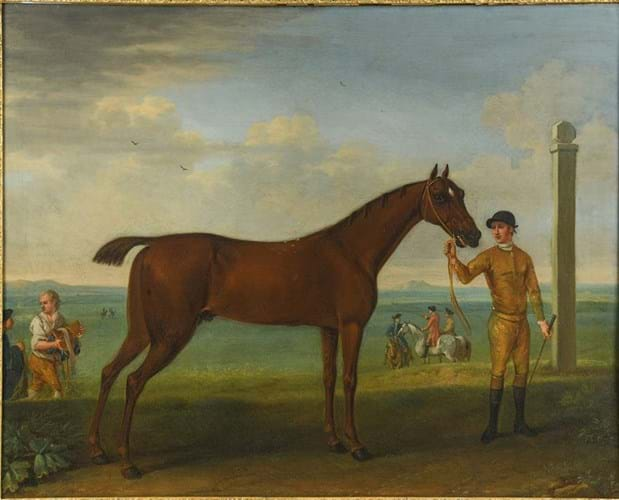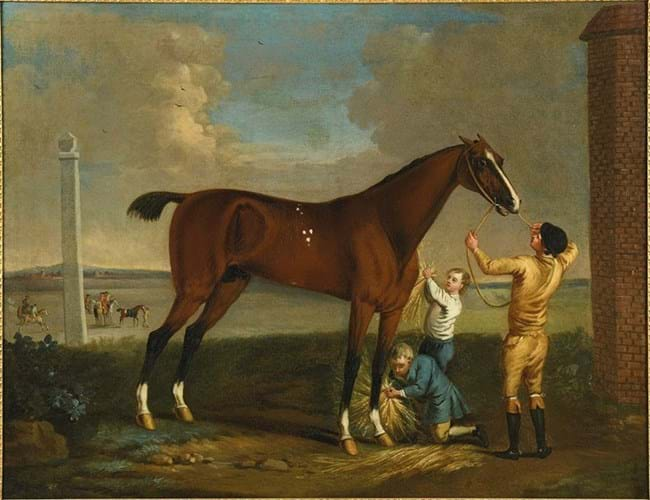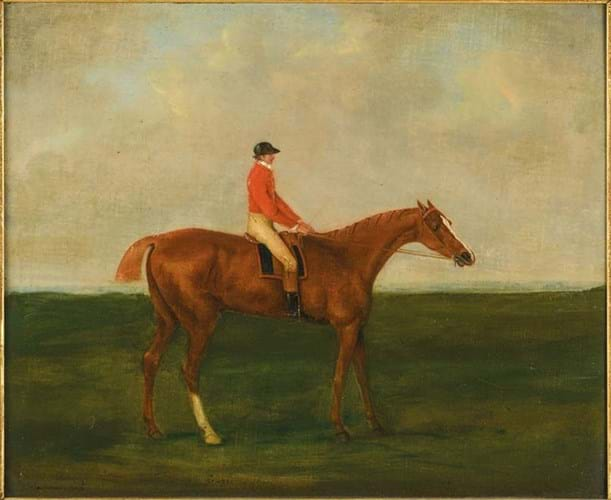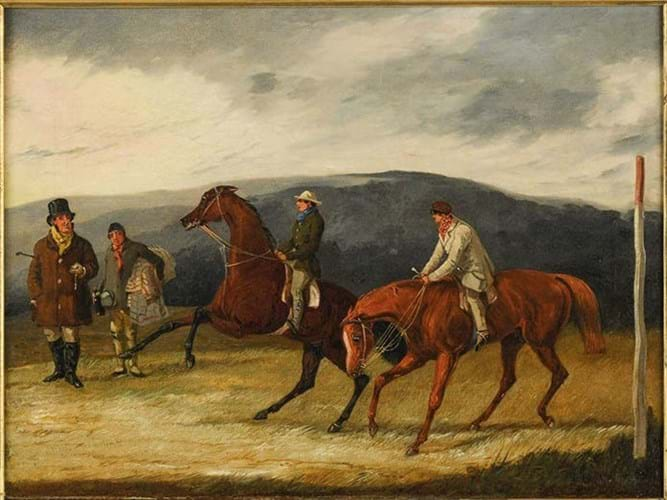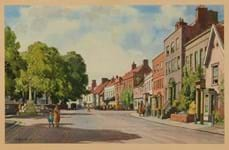It may have been a while since a sale of sporting art truly raced away at auction but a high-calibre 20-lot collection with exceptional provenance recently proved that this sector can still create competition for blue riband material.
The works offered at Cheffins (25% premium) in Cambridge on October 1 were not the run-of-the-mill Victorian or Edwardian scenes that appear frequently on the market. Most were either paintings by leading names of their day or depicted some of the most famous racehorses of the 18th and early 19th century.
Indeed, horse racing pictures are a somewhat removed sub-category of the sporting sector (like works relating to hunting, shooting and fishing) and rare pictures relating to the early history of the sport of kings retain an enthusiastic and wealthy collecting base. It is also an area where some of the trade’s big hitters continue to operate.
King visits Newmarket
The works at Cheffins were led by a painting with a seminal subject in racing lore: a panoramic view recording George I’s only visit to Newmarket Heath in 1717 by the Anglo-Flemish sporting and topographical artist Peter Tillemans (1684-1734).
It overshot a £40,000-60,000 estimate and sold at £125,000 (see our Pick of the Week in ATG No 2463). This was among the highest prices for a sporting picture sold in the English regions in recent years.
The group of paintings came from a private collection previously kept at a country house near Bury St Edmunds in Suffolk. Initially begun in 1849 by the MP John Dunn Gardner (1811-1903) of Denston Hall, Suffolk, the collection was later added to by his son Algernon Dunn Gardner (1853-1929).
The fact that the 20 works had been in private hands for over a century certainly helped generate interest. They raised a combined £432,600, a hefty chunk of the overall sale total of £750,000.
Nicolas Martineau, associate in Cheffins’ fine art department who was on the rostrum for the whole sale, reported bidding from both trade and private clients. “It’s heartening to see sporting art selling so well.” he said.
“While this may not be indicative of a resurgence of the market per se, it does show that there is still a very active buyer base for sporting art if it is of the highest quality and by some of the biggest names in the genre.”
Wootton work
One of those names is John Wootton (c.1682-1764), an artist regarded as the prime British bloodstock painter during an age when racing was fast becoming a national pastime. Works appear occasionally on the market, although not all feature his commercially lucrative racing subjects (he also painted hunting pictures, landscapes and dog portraits).
Four Wootton racing pictures were on offer at Cheffins, each selling to different private collectors – a good sign for the market – including a near pair of works depicting two fine racehorses at Newmarket.
A chestnut racehorse held by his jockey and A bay racehorse being rubbed down, both approximately 3ft 2in x 4ft 1in (97cm x 1.25m), had been bought by Algernon Dunn Gardner from dealer Fores of Piccadilly in 1913. At the time they were acquired the subjects were identified as two famous racehorses: King Herod and Flying Childers.
However, Cheffins said that research undertaken since showed this was not the case and it was specified in the catalogue that these were paintings of unknown thoroughbreds.
Even still, the fact that these were good-sized paintings by Wootton and the horses and central figures were deemed well conceived and handled, plus the presence of the Newmarket landscape and other figures to the background, made them valuable.
First up was A chestnut racehorse… at the higher estimate of £70,000- 100,000, partly on account of the fact that the oil on canvas was signed J Wootton fecit. It sold at £75,000.
A bay racehorse… was estimated at £50,000-70,000 but drew more competition to sell to an online buyer at £74,000.
In the last five years only two works by Wootton have fetched more at auction: King William III stag hunting that made £310,000 at Sotheby’s in December 2019 and The Meet: A hunting party, with figures, horses and hounds that sold for £240,000 at Christie’s in July 2015 (source: Artprice by Artmarket).
Another racehorse portrait by the artist at Cheffins, also acquired by Dunn Gardner from Fores, was The Bloody Shouldered Arabian which sold for £45,000 against a £30,000-50,000 pitch. The famous subject – the Arabian stallion sent from Aleppo to Edward Harley by his uncle Nathaniel Harley – was painted a number of times by Wootton, although the exact number of original versions is not known for definite.
Signed versions have previously made £193,250 including premium at Christie’s in July 2011 and £326,000 at Halls in Shrewsbury in October 2010. Although unsigned, this picture had a provenance to Wimpole Hall, Cambridgeshire – a property owned by Edward Harley.
The fourth Wootton was a painting of the racehorse Old Partner that made a low estimate £15,000.
Sartorius quartet
Another well-known name in 18th century racing pictures who was represented at Cheffins was John Nost Sartorius (1759-1828). Four works were offered which sold to three different buyers for a combined £39,300.
The highest price came for an equestrian portrait of the 3rd Duke of Grafton (1735-1811) riding his hunter and attended by his mounted groom. A formal picture rather than a racing scene, it sold under estimate at £17,000.
Good competition came for a painting of the famous racehorse Eclipse with the jockey, John (Jack) Oakley, up in the saddle. Foaled at the stud of the Duke of Cumberland, Eclipse first ran at Epsom in 1769, winning easily at 4-1 on.
For the second heat that day, Irish gambler Dennis O’Kelly made a wager that he could place all the horses in order, pronouncing as he did so one of the most famous phrases in racing history: “Eclipse first, the rest nowhere.”
After an extraordinary albeit short-lived racing career, Eclipse was retired early to stud after winning all 18 of his races. His stud fee was 50 guineas a mare and he is believed to have sired around 350 winners.
The painting, a 13½ x 16½in (34.5 x 42cm) signed oil on canvas, drew strong interest against a £4000- 6000 estimate and was knocked down at £11,000 – a decent sum for a work of this size.
'Wizard of the North' depicted
Also bringing solid competition was a painting by Henry Alken Snr (1785-1851) of trainer John Scott at an early morning training trial between the famous Cotherstone and another horse, probably Napier which was owned by a friendly competitor.
Scott was one of the leading trainers of his day. Based in Malton, North Yorkshire, he was known as the ‘The Wizard of the North’.
Cotherstone was bred at Streatlam Castle, County Durham, and in 1843 won the 2000 Guineas at Newmarket and the Derby, although narrowly missed out on being the first winner of the Triple Crown when he was beaten by a head in the St Leger.
The 11¾ x 15¾in (30 x 40cm) signed oil on canvas was estimated at £8000-12,000 and, although there were a few condition issues, including some wear, abrasions and areas of retouching, it still sold on top estimate, making the highest price for an Alken Snr in the UK regions for the last few years.


